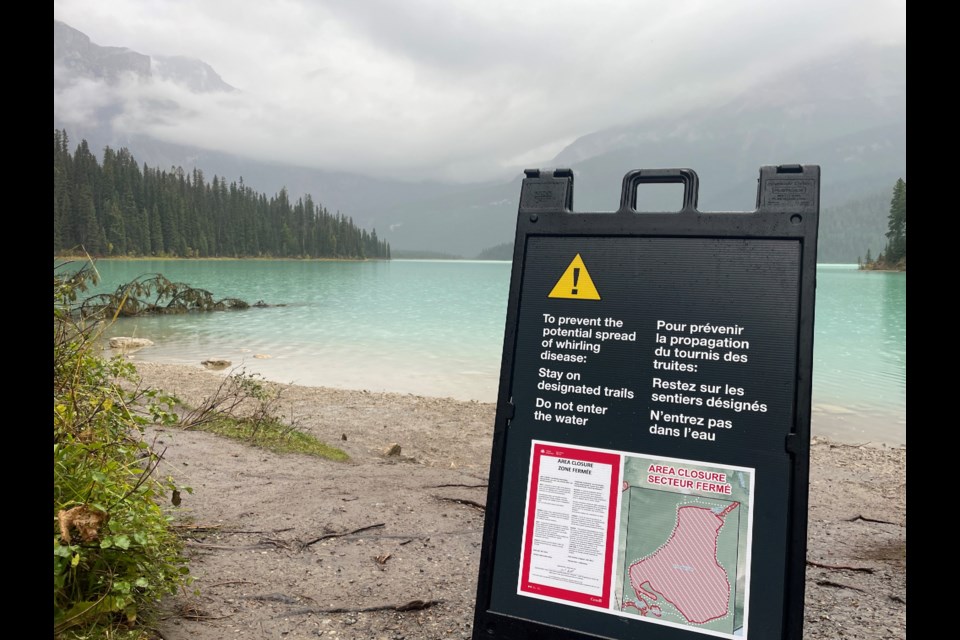YOHO NATIONAL PARK – Parks Canada is doubling down and extending activity closures into spring, summer and fall to tackle the onslaught of whirling disease in water bodies in Yoho and Kootenay national parks.
All water bodies in the national parks are closed to watercraft and angling until March 25, 2025, to reduce the risk of further spread of the deadly disease and to protect vulnerable fish species at risk.
“Those closures are designed to help protect fish species vulnerable to whirling disease, including several trout species and Kokanee salmon,” said François Masse, Lake Louise, Yoho and Kootenay field unit superintendent at a virtual media conference Tuesday (March 19).
“The closures will also provide Parks Canada with the opportunity to conduct further sampling and monitoring actions, which will inform future management actions.”
Parks closed all water access in Yoho and Kootenay national parks following the discovery of a case of whirling disease in Emerald Lake, B.C. on Oct. 27, 2023 – the first case detected in the province. Further testing revealed traces of the disease in the Kicking Horse River, Wapta Lake, Finn Creek, Monarch Creek and the confluence of the Emerald and Kicking Horse rivers, leading to extended water access restrictions until March 31, 2024.
Over winter, Parks analyzed options to determine how to best mitigate risk posed by the disease. Once established, it is very difficult to eradicate and has the potential to decimate fish populations, with mortality rates up to 90 per cent in young fish. There is no treatment for the disease.
Recreational watercraft is one of the main ways aquatic invasive species is transferred between water bodies.
“They can pick up things like mud, sand and sediments, plant fragments, and if their equipment is not cleaned of all of that – drained of any standing water and dried for a certain amount of time – then that poses a big risk of transferring aquatic organisms that are hiding in the water and mud, and little cracks in watercrafts, between water bodies,” said Jeanette Goulet, ecosystem scientist and regional program coordinator for aquatic invasive species programs in the mountain national parks.
Whirling disease is named for the distinctive circular swimming patterns exhibited by infected fish. The parasite responsible for the disease can infect many fish species including bull trout, westslope cutthroat trout, rainbow trout, mountain whitefish, brown and brook trout.
Goulet said aquatic invasive species teams will be on the ground throughout the closure period to ensure public compliance.
Those found non-compliant could face a fine of up to $25,000 under the National Parks Act.
Based on monitoring and compliance levels, Parks Canada may re-evaluate and enforce additional measures, if necessary.
Goulet noted some areas tested along the Kicking Horse River came back negative for whirling disease, indicating it may have been detected early.
“The prominence in the samples was slightly different between the different sample sites. But it seems, from the results, that it might have been caught at an early stage of infection,” she said.
“It was a bit difficult for us to actually get the confirmation of the spores of whirling disease in the samples. So, because those weren’t easily seen in the samples that we took, we think that maybe we have caught this at an early stage.”
Parks considered eradicating infected fish with rotenone – a plant-based chemical that’s been used in the past to kill off localized non-native fish – when it detected the presence of whirling disease in Emerald Lake. However, Goulet said further testing revealing traces in the Kicking Horse River and with the chemical capable of killing all fish, along with the river’s connectivity with other water bodies, it was deemed not feasible.
“Just with the size of that river system, we thought about it but realized it’s not feasible for us to treat that size of a river system with rotenone,” she said.
At this stage, Goulet said Parks Canada is “waiting for a little bit more information on the broader context of whirling disease within the province of British Columbia.
“Once we have a little bit more information on that, we will probably look at other ways that we could manage the situation.”
The best way to prevent spreading invasive species is to properly clean, drain and dry watercraft, she noted.
Waterton Lakes National Park superintendent Locke Marshall said whirling disease was also detected downstream of the Waterton Dam in 2023.
A non-motorized watercraft inspection program has been operating in the national park since 2021 to prevent the spread of aquatic invasive species such as zebra and quagga mussels, he noted, however, compliance with the program has remained low, with only 56 per cent of non-motorized watercraft users participating in the program in 2023.
As a result, stricter measures are being introduced in Waterton Lakes National Park and non-motorized watercraft from outside the park will not be permitted in water bodies inside the park starting April 1, 2024.
“Protecting national parks is a shared responsibility and each visitor has an important role to play, and we thank them and you in advance for respecting these changes,” he said.
The Local Journalism Initiative is funded by the Government of Canada. The position covers Îyârhe (Stoney) Nakoda First Nation and Kananaskis Country.




